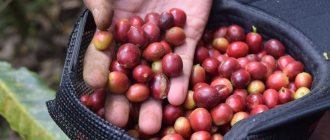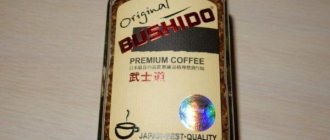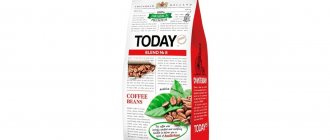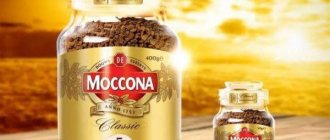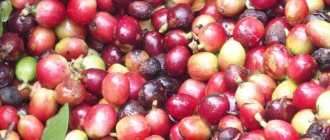Primary processing of grains
It is divided into 2 types:
Dry processing of grains
This type of processing is considered the most ancient. Dry processing consists of scattering the fruits in a thin layer on the ground, brightly illuminated by the sun. Since the fruits have a fairly high moisture content, it is very important to constantly turn them so that they do not become damp and, as a result, become moldy. For the same purpose, they are covered at night. After 2 weeks, the pulp covering the grains becomes dry and turns brown, and the seeds inside dangle freely. This method is considered the most gentle for coffee beans. In some coffee-producing countries, the fruits are not collected, but are waited on the trees to dry, when they themselves fall onto a cloth specially spread under the trees. The fallen seeds are then sifted and cleaned.
Wet (wet) processing of grains
The essence of this method is that the coffee beans are not dried, but rather passed through a machine resembling a mill. The machine cleans in such a way that all the coarse pulp is removed, and the grain remains only in a thin shell. It is believed that this type of processing is a continuation of picking, when the raw materials are collected by hand, leading to practical uniformity of the grains.
After the pulp has been removed from the fruit using machines, the seeds are sent for washing, which takes place in channels specially built for this purpose. They are not made in the form of straight lines, but slightly twist. This allows you to better wash the grains and detect among them the diseased ones that begin to float up. This method of grain selection is considered the initial stage of sorting. After the grain is washed, it is sent for fermentation. This is done to remove insoluble particles of pulp remaining after washing. In order for the grain to pass through this stage normally, it is constantly turned over, exposing as much of the surface of the grain as possible to the sun. Typically, this stage lasts up to 24 hours. After this, the grain is sent for repeated washing. This method has become widespread relatively recently, as a result of which the coffee produced in this way is considered to be of very high quality. But this is a very expensive production technology because it requires large quantities of good quality water. But many coffee-producing countries do not have this opportunity. Therefore, some manufacturers use water several times to save money.
Of course, this significantly reduces the cost of work, but at the same time deteriorates the quality of the finished product. With repeated use of water, its acidity level increases significantly, which gives the finished product a very unpleasant taste and smell. Another disadvantage of the wet method is the risk of leaving at least a few beans in special pools designed for coffee fermentation. In this case, they will be fermented several times, which will ultimately ruin the entire batch of finished coffee. And this will not appear immediately, but only during the roasting process, when these grains begin to emit an unpleasant odor, spreading it to the grains of the entire batch.
And how to choose good coffee in a store?
If you have just entered the world of coffee and are choosing your first blend, pay attention to such top brands as Lavazza, Kimbo, Hausbrandt, illy.
These brands are available in many stores. Choose a blend of 100% Arabica or with a small amount of Robusta ~80%/20% medium roast. Try and compare 2-3 different mixtures and then you will get an impression of your own preferences. ★ Especially for those who are just starting to discover the taste of coffee, we have prepared a special test set of 5 different mixtures in a small package at a competitive price, so that you can try and compare the taste of coffee from different manufacturers, from different types and varieties of beans, from different price categories and decide which coffee is right for you. The same rules apply to the choice of ground coffee. If you are lost among a large assortment of blends, take a look at our selection - the rating of the best coffee beans; the characteristics and taste qualities of the top blends from our store are described in detail there. If you are already a long-time fan of coffee and you have your favorite blends, but you want to try something new and not make a mistake, then pay attention to the composition, the proportions of Arabica/Robusta in the mixture, roasting and choose coffee based on similar parameters. There is a good chance that you will also like the new coffee.
But we also encourage you to experiment and try different mixtures. After all, the world of coffee is limitless and it’s so interesting to discover new tastes!
We can also advise you on the entire assortment of the store and try together to choose the coffee beans that are right for you!
Choose coffee beans >>
Roasting beans
Thermal type of roasting beans into 2 subtypes: contact and convective.
Thermal contact method
With the contact method, the grain is roasted by direct exposure to heat resulting from the contact of the seeds with the hot surface of the machine in which the roasting takes place. At the same time, the grain is stirred all the time so that it does not overcook. This subtype of roasting is considered the worst, since coffee is often over-roasted and the color of the beans is uneven, which deteriorates the quality of the finished product.
Thermal convective method
The convective method uses heated air, which enters the chamber where the frying process takes place. In this case, the grain is also subjected to constant mixing. The quality of the product resulting from this roasting method is significantly higher, since the grain is roasted more evenly; the grains have a uniform, uniform color - all this improves the appearance of the finished product.
Dielectric method
It is carried out using microwave energy, which penetrates deep into the coffee bean and roasts it. An important feature of this method is that the coffee beans do not come into contact with any heated surfaces at all, and this significantly increases its quality.
Radiation method
Today this is one of the newest and most advanced processing methods, which has not received significant distribution due to the high cost of the equipment, and also, most likely, due to prejudices associated with radiation. First, the coffee beans are illuminated with gamma rays and then roasted using standard heat treatment.
Coffee production equipment
The most affordable type of this business is the production of coffee beans, since it only requires:
- Roaster (apparatus for roasting grains). A roaster with a capacity of 10-25 kg per hour will cost from $3500.
- Installation for cleaning grains from debris.
- Apparatus for blending. Helps create blends from various varieties and types.
- Equipment for packing.
What does bean coffee production look like?
Video of the roaster in action:
The complete list of equipment for the production of granulated instant coffee differs very significantly: these are bunkers (containers) for raw materials and semi-finished products, and various scales, and vibration separators and coolers, vibrating screens, conveyors and elevators, granulators, pumps, drums for roasting beans, and many other devices.
Together, they form a coffee production line with a total value of about $3 million.
Prices for equipment using freeze dried technology range from $15 million to $40 million.
If the appropriate production facilities and other infrastructure exist, then the production of freeze-dried coffee will cost much less - only about $3.5 million.
Cereal products
During the 2015 crisis, a small proportion of citizens changed the brand to a cheaper one of the same bean coffee. This is explained by the fact that Russia has jumped into the era of quality products, because now everyone knows that whole grains are healthier.
The share of domestic trade turnover accounts for 66% of natural coffee produced by Russian companies. Among them:
- "Orimi Trade"
- "Moscow coffee shop on shares"
- Tea and coffee shop
Foreign firms such as Paulig are also present. This Finnish company recently opened a bean roasting plant in the Tver region. The income of this company can be considered one of the largest.
Worldwide requests and offers
As of 2021, the market structure has changed dramatically. If you look back at 2001, you will notice the following trends:
- Compared to 2001, in 2021 the demand for instant products has decreased. This is explained by rising wages among Russians, as well as effective advertising and the proven benefits of grain. If in 2001 a survey showed that 86% of respondents prefer instant drinks, while the same figure has now dropped to 49% and continues to decline.
- In 2021, the approximate consumption figure for this delicacy in Russia was 250,000 tons, and it also continues to rise.
- There are about 2 kilograms of these products per year per citizen.
- The record holders for drinking are citizens of Finland and Denmark, where the consumption of the drink per year per person is 12 kilograms! This figure in Europe is slightly less - only 8 kg per person, which is also much more than in Russia.
- Russian grain lovers are also divided into two groups: 37% of Russians buy grain, and the rest buy already ground grains.
- Since the coffee market in Russia is only growing, our citizens have become better aware of the varieties of beans, as well as the countries that produce them.
- A survey conducted in 2021 in Moscow showed that: 90% prefer the drink for breakfast, 45% during the day, in the evening the figure drops to 20%, and at night 3-5% of respondents drink this product.
- According to the same survey, Muscovites prefer to prepare the drink at home (95%), some drink the drink at work (45%), the rest buy a treat in a cafe (20%), another small group prefers to treat their guests (19%). At the same time, a considerable part of people take a glass with them when they go for a walk (10%).
Export to Russia
Russian companies have been exporting finished products to European countries and the CIS for a long time. Foreign companies are interested in:
- Naturally roasted product with caffeine (about 75% in granulated and ground form);
- Arabica (23%);
The main exporting countries are the former Soviet republics - Belarus, Abkhazia and others. Until recently, the largest consumer of Russian products was Ukraine (69% of exports), but due to difficult political relations this percentage has decreased significantly.
In Russia, the most important exporters are two capitals - Moscow and the region (45%), St. Petersburg and the region (40%). About 52 domestic companies operate in this specialization. But only 4 of them are large and take up about 85% of all processing.
Who is the consumer?
It’s quite easy to depict the face of a modern gourmet:
- The aromatic delicacy is mainly consumed by residents of large cities with a fast pace of life (73% of all consumers).
- Mostly working people drink this invigorating treat; work often involves long-term mental or physical stress, which requires additional energy.
- The main consumers are people aged 20 to 50 years, students in higher educational institutions, those with an academic title and an average level of income.
- The interest of experts was aroused by the fact that the majority of consumers buy their favorite brand (35% of respondents); it is very difficult to convince them. Another part can choose from 3-4 brands; a very small share is occupied by people who often try new varieties (7%).
Soluble products
In 2021, the demand for grain products has sharply increased; decent establishments offering quality treats are opening in small towns. Due to this, the demand for instant drinks has decreased. However, grain products still have a high price, so not everyone can afford it.
The product in granules remains predominant, followed by crystalline and powder, the benefits of which are quite questionable. Meanwhile, the demand for high-value products is growing. Manufacturers approached the issue competently; the composition of the soluble product must meet not only the requirements of customers, but also our standards.
Leading manufacturers
The leaders of the coffee market in Russia can be divided into several groups according to various classifications.
- For companies with a controlling stake:
- Domestic (("Orimi Trade", "Moscow coffee shop on shares", LLC "Tea and Coffee", Strauss Group)
- Wide range of products (Nestle Russia, Mondelez, Orimi-Trade).
- By type of product:
- Beans (Paulig)
- Mixed (Nestle Russia, Tchibo, Strauss Group, Orimi-Trade, Moscow Coffee House on Shares)
- Granular (Mondelez).
- By quantity produced
- Less than 2500 tons/year (Nestle Russia, Mondelez, Tchibo, Paulig, Orimi-Trade, Strauss Group
- From 700 to 3200 tons/year (“Moscow coffee shop on shares”, “Russian product”);
- More than 700 tons/year (“Montana Coffee”, “Safari Coffee”, etc.).
More than half of the instant product is created by three main companies: Nescafe Russia, Mondelez and Tchibo. Nescafe can be called a leader, since the company produces half of all products.
If we talk about grain, about 70% is produced by Russian companies listed above in the lists. The foreign company Paulig Group remains in fourth place. Let's take a closer look at the largest companies.
Nestle Russia:
The first time we heard about this company was 22 years ago. It was opened in Moscow and almost immediately occupied most of the market. Now her main task has become to strengthen sales, since the company is sufficiently advertised in Russia. Production is in full swing. This company occupies a large part of the domestic coffee market in all its segments.
Mondelez
The holding is a year older than the previous one; it used to be called Kraft Foods Russia. Has the same production.
Tchibo
The very first company on the Russian market appeared 24 years ago. Its main task is to expand its sphere of influence and active sales.
"Moscow coffee shop on shares"
opened in 1997. The first plant was launched in Eastern Europe in 2004-2005. The products are also extensive, presented in various variations on the domestic and world markets.

